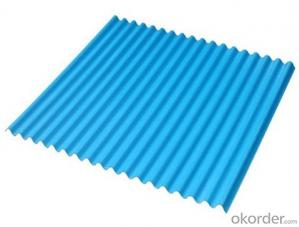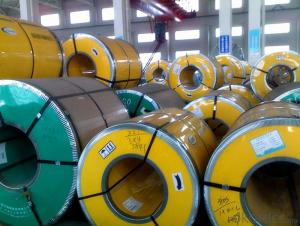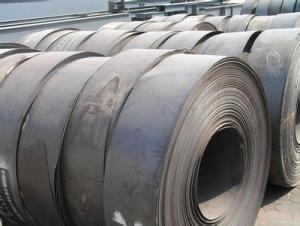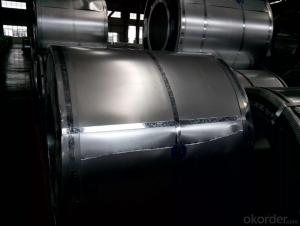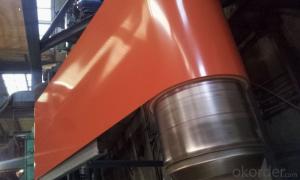Premium Quality Corrugated Galvanized Steel Sheet
- Loading Port:
- Tianjin
- Payment Terms:
- TT OR LC
- Min Order Qty:
- 50 m.t.
- Supply Capability:
- 2000 m.t./month
OKorder Service Pledge
OKorder Financial Service
You Might Also Like
Item specifice
Product Brief Introduction
Premium Quality Corrugated Galvanized Steel Sheet
Galvanized Corrugated Steel Roofing Sheet is formed by cold roll machine, using galvanized steel sheet or aluminum steel as the base material .Galvanized corrugated steel roofing sheet is featured with easy installation ,high strength ,more economic .(and low cost )
Product Features
.Surface have been treated as galvanized and color coated.so it can anti-rain,anti- fire,anti-quake,So it has a long term life as 20-30 year and color just not fade.
. Light weight: easy to transport the material,short the time to finish the building,reduce worker's hard work,save much time and energy for human beings.
.Smooth surface treatment,the dust will be easy taken off by the rain.
. Environmental material,can be used many times,will do no hard to the our environment.
Product Specification
Premium Corrugated GI Galvanized Steel Sheet
Packing Information (For 27.5 Tons heavy 20’Fcl)
. water proof paper packing inside
. plastic film Packing in middle
. steel sheet Packing outside
.several steel strip packing to fix the packing
Production Line & Package
FAQ
1. how many wave for per pcs
—— some wave is 8 ,same wave is 9 ,save wave is 11 ,it is up to your request
2. What is the MOQ for this products ?
—— Normally the MOQ is 25mt per size and per color .

- Q:Are steel strips suitable for the manufacturing of architectural structures?
- Yes, steel strips are suitable for the manufacturing of architectural structures. Steel is known for its strength and durability, making it an ideal material for constructing buildings and other architectural structures. Steel strips are often used in various applications such as framing, support beams, and cladding, providing structural integrity and stability to the overall structure. Additionally, steel strips offer flexibility in design, allowing for creative and innovative architectural solutions.
- Q:How are steel strips used in the production of metal grating?
- Steel strips are used in the production of metal grating to provide structural support and reinforcement, as they are strong and durable. These strips are typically welded or interlocked together to create a grid-like pattern, forming the base of the metal grating. This construction method ensures that the grating can withstand heavy loads and provide a stable walking surface, making it suitable for various industrial and commercial applications.
- Q:What are the dimensional inspection methods for steel strips?
- Some common dimensional inspection methods for steel strips include calipers, micrometers, optical comparators, laser scanners, and coordinate measuring machines (CMMs). These tools are used to measure dimensions such as thickness, width, length, and straightness of the steel strips to ensure they meet the required specifications.
- Q:Can steel strips be used in the construction of railways?
- Yes, steel strips can be used in the construction of railways. Steel strips, commonly known as steel rails, are widely used in railway tracks due to their high strength, durability, and ability to handle heavy loads. They provide a stable and smooth surface for trains to travel on, ensuring safe and efficient transportation. Additionally, steel strips can withstand various weather conditions and require minimal maintenance, making them an ideal choice for railway construction.
- Q:Are steel strips suitable for making automotive parts?
- Yes, steel strips are suitable for making automotive parts. Steel strips have several properties that make them ideal for automotive applications. Firstly, steel is known for its strength and durability, which are essential qualities for automotive parts that need to withstand high levels of stress and impact. Additionally, steel strips can be easily fabricated into various shapes and sizes, allowing for the production of complex automotive components. The malleability of steel strips also enables them to be formed into tight curves and angles, ensuring a precise fit for automotive parts. Moreover, steel is relatively affordable compared to other materials, making it a cost-effective choice for automotive manufacturers. Lastly, steel strips have excellent corrosion resistance properties, which is crucial for automotive parts exposed to various weather conditions and road environments. Overall, steel strips offer a combination of strength, versatility, affordability, and corrosion resistance that makes them highly suitable for making automotive parts.
- Q:What are the environmental impacts of steel strip manufacturing?
- The environmental impacts of steel strip manufacturing include air pollution from emissions of carbon dioxide, sulfur dioxide, and nitrogen oxide, which contribute to climate change and air quality degradation. Additionally, the manufacturing process consumes significant amounts of water and energy, contributing to water scarcity and increased greenhouse gas emissions. Steel strip manufacturing also generates solid waste, such as slag and scale, which can contaminate soil and water if not properly managed. Overall, it is essential to implement sustainable practices and technologies to minimize these environmental impacts and promote a more eco-friendly steel strip manufacturing industry.
- Q:What are the different surface laminating options for steel strips?
- Some of the different surface laminating options for steel strips include galvanizing, painting, powder coating, and vinyl cladding.
- Q:How do steel strips contribute to energy efficiency in various industries?
- Steel strips play a vital role in enhancing energy efficiency across multiple industries in diverse ways. To begin with, the construction industry extensively utilizes steel strips to create energy-efficient buildings. Steel exhibits impressive thermal conductivity, facilitating efficient heat transfer between a building's interior and exterior. Consequently, this enables better insulation, reducing the need for excessive heating or cooling, ultimately conserving energy and decreasing energy costs. Moreover, energy-efficient appliances and equipment often incorporate steel strips in their manufacturing. For instance, energy-efficient refrigerators, air conditioners, and boilers frequently employ steel strips. The strength and durability of steel enable the production of more efficient appliances that consume less energy during operation. Additionally, steel strips form an integral part of renewable energy systems. Steel is employed in constructing support structures, frames, and other components of wind turbines, solar panels, and hydropower equipment. This utilization of steel ensures the stability and durability of these renewable energy systems, enabling the harnessing of clean energy while minimizing the energy required for maintenance and operation. Lastly, the transportation industry relies on steel strips to enhance energy efficiency. Steel is widely employed in producing lightweight yet robust components for automotive and aerospace applications. By reducing the weight of vehicles and aircraft, steel strips contribute to improved fuel efficiency and reduced emissions, which is particularly significant in the context of electric vehicles, where lighter materials optimize battery life and extend driving range. In conclusion, steel strips are crucial in promoting energy efficiency across various industries. Whether in construction, manufacturing, renewable energy, or transportation, steel strips actively contribute to reducing energy consumption, enhancing insulation, and improving the overall sustainability of industrial processes.
- Q:How do steel strips handle thermal expansion?
- Steel strips handle thermal expansion by expanding and contracting along their length when exposed to changes in temperature. This is due to the property of steel to expand when heated and contract when cooled. To accommodate this expansion and prevent damage or distortion, steel strips are designed with appropriate allowances and expansion joints, allowing them to expand and contract freely without causing any structural issues.
- Q:What are the safety precautions when handling steel strips?
- To ensure safety when handling steel strips, it is important to keep the following precautions in mind: 1. Personal Protective Equipment (PPE): It is essential to wear the appropriate PPE, such as safety glasses, gloves, and steel-toed boots. This will safeguard against potential hazards like sharp edges, flying debris, or accidental drops. 2. Employ Correct Lifting Techniques: Due to the weight and bulkiness of steel strips, it is crucial to use proper lifting techniques to avoid strain or injury. Bend your knees, maintain a straight back, and utilize your leg muscles for lifting. If necessary, employ lifting aids or equipment for assistance. 3. Ensure Secure Storage and Handling: Store and handle steel strips securely and in an organized manner to prevent falling or shifting, which can lead to injury. Employ suitable storage racks, pallets, or straps to maintain stability during transport or storage. 4. Prevent Slips, Trips, and Falls: Keep work areas clean and free from obstacles, spills, or debris that could cause slips, trips, or falls. Maintain good housekeeping practices and use anti-slip mats or flooring when necessary. Be cautious of uneven surfaces or slippery conditions, particularly when moving or transporting steel strips. 5. Mind Sharp Edges and Burrs: Steel strips may have sharp edges or burrs that can cause cuts or lacerations. Inspect the strips for any sharp edges and, if necessary, use deburring tools to remove burrs. Handle the strips with caution to avoid accidental cuts or scrapes. 6. Ensure Proper Equipment and Machinery: When utilizing equipment or machinery for handling steel strips, ensure they are in good working condition and adequately maintained. Adhere to all safety guidelines and instructions provided by the manufacturer. Never operate equipment without proper training or authorization. 7. Communication and Teamwork: If working as part of a team, effectively communicate with colleagues to ensure awareness of assigned tasks and potential hazards. Practice teamwork and provide assistance when needed, especially during the lifting or movement of heavy steel strips. By adhering to these safety precautions, the risk of accidents, injuries, and damage when handling steel strips can be minimized. Always prioritize safety and take necessary precautions to protect yourself and others in the workplace.
1. Manufacturer Overview |
|
|---|---|
| Location | |
| Year Established | |
| Annual Output Value | |
| Main Markets | |
| Company Certifications | |
2. Manufacturer Certificates |
|
|---|---|
| a) Certification Name | |
| Range | |
| Reference | |
| Validity Period | |
3. Manufacturer Capability |
|
|---|---|
| a)Trade Capacity | |
| Nearest Port | |
| Export Percentage | |
| No.of Employees in Trade Department | |
| Language Spoken: | |
| b)Factory Information | |
| Factory Size: | |
| No. of Production Lines | |
| Contract Manufacturing | |
| Product Price Range | |
Send your message to us
Premium Quality Corrugated Galvanized Steel Sheet
- Loading Port:
- Tianjin
- Payment Terms:
- TT OR LC
- Min Order Qty:
- 50 m.t.
- Supply Capability:
- 2000 m.t./month
OKorder Service Pledge
OKorder Financial Service
Similar products
New products
Hot products
Related keywords
